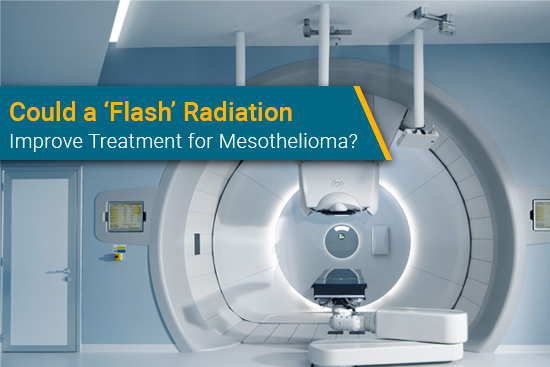Estimated Read Time: 2 minutes
One of the challenges for mesothelioma specialists is providing treatment with limited or no side effects. This is especially true for radiotherapy, which often leads to uncomfortable complications.
What seems like a never-ending dilemma may soon come to an end — thanks to a new type of radiation therapy.
The advancement of FLASH radiation therapy, or FLASH-RT for short, was the focus of research at the University of California-Irvine. Interested medical experts tested this technique on brain cancer in mice and discovered extraordinary results.
The most significant benefit, aside from shrinking the tumor and killing diseased cells, is limiting the damage to neighboring healthy organ tissue.
How Does FLASH Radiotherapy Work?
Traditional radiation therapy, also called photon radiotherapy, directs beams to the tumor environment for several minutes. FLASH-RT delivers the same dose in a fraction of the time.
The hyper-focused, speedy method diminishes the potential for wayward radiation beams hitting healthy tissue just outside the target area.
“As in traditional radiation therapy, the researchers fractionated the dose — divided the total over several sessions,” states the press release from the University of California-Irvine. “Using FLASH-RT, they found that the same total dose of radiation delivered at quicker dose rates removed … tumors just as effectively as the traditional method.”
A radiotherapy technique that hyper-focuses on only the tumors could translate to treating mesothelioma. Specifically, people with pleural mesothelioma hold the largest stake. This cancer forms in the thin, protective lining between the lung cavity and chest wall.
The proximity to the lungs means pleural mesothelioma often spreads to and damages the tissue on this organ. Traditional radiation usually damages the sensitive lung tissue around the tumors, which causes permanent tissue scarring and other potential issues.
Comparing FLASH Radiotherapy to Other New Radiation Techniques
Proton beam radiotherapy is a recent emergence and improvement in cancer treatment. This technique, along with intensity-modulated radiation therapy, condenses the beam’s radius.
One study found that proton radiation for mesothelioma limited pneumonitis (inflammation of lung tissue) to just 13% of patients. IMRT leads to severe pneumonitis for between 15% and 20% of mesothelioma patients. Traditional radiotherapy has even higher complication rates.
FLASH-RT could all but eliminate the potential for inflamed lung tissues. The researchers noted that this new mesothelioma treatment has helped lung cancer patients in avoiding radiation side effects.
If you’re interested in radiation therapy, including new-age techniques to prolong life and improve quality of life, contact our medical team. Patient advocate Karen Ritter is a registered nurse with connections at many top-ranked hospitals and radiation centers. You can email her at karen@mesotheliomaguide.com.
Sources & Author
- Light-activated cancer drugs without toxic side effects. EurekAlert. Retrieved from: https://www.eurekalert.org/news-releases/540166. Accessed: 11/16/2020.
- Consensus Statement on Proton Therapy in Mesothelioma. Practical Radiation Oncology. Retrieved from:
https://www.practicalradonc.org/article/S1879-8500(20)30117-X/pdf. Accessed: 06/10/2020.
About the Writer, Devin Golden
Devin Golden is the senior content writer for Mesothelioma Guide. He produces mesothelioma-related content on various mediums, including the Mesothelioma Guide website and social media channels. Devin's objective is to translate complex information regarding mesothelioma into informative, easily absorbable content to help patients and their loved ones.
Sources & Author
About the Writer, Devin Golden
Devin Golden is a content writer for Mesothelioma Guide. He produces mesothelioma-related content on various mediums, including the Mesothelioma Guide website and social media channels. Devin's objective is to translate complex information regarding mesothelioma into informative, easily absorbable content to help patients and their loved ones.



